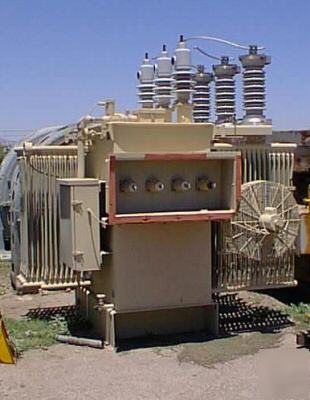|
Dear shopper: We hope you'll find our items interesting and useful [All derivative (i.e. change in media; by compilation) work from this underlying public domain/public release, anonymous, or non-US copyrighted data is COPYRIGHT © The Learning Company* Check the laws of your country. This handbook covers design criteria for electric power distribution systems including basic data, overhead and underground distribution systems, submarine cable systems, and substations. The basic design guidance has been developed from extensive reevaluation of facilities and is intended for use by experienced professionals. Evaluation and Selection of Energy Systems CHAPTER 2. ELECTRICAL POWER REQUIREMENTS System Voltage Classifications Selection of Primary Distribution Voltage for New Installations Selection of Primary Distribution Voltage for Existing Installations Commercial Power for Air Force Installations Selection of Primary Distribution Voltage for Air Force Installations CHAPTER 4. MAIN ELECTRIC SUPPLY STATIONS/SUBSTATIONS Station Designation and Elements Main Electric Supply Station/Substation Incoming Line Switching Equipment Miscellaneous Station Design Criteria Substation Equipment at Air Force Installations CHAPTER 5. ELECTRIC DISTRIBUTION LINES Pad-Mounted Line Sectionalizing Equipment Joint Electrical/Communication Lines for Air Force Installation CHAPTER 6. AERIAL DISTRIBUTION LINES CHAPTER 7. UNDERGROUND DISTRIBUTION LINES Manholes, Handholes, and Pullboxes Direct-Burial Cable Installations CHAPTER 8. TRANSFORMER INSTALLATIONS Installation of Distribution-to-Utilization Voltage Transformers Installation of Transmission-to-Distribution Voltage Transformers Amorphous Metal-Core Transformers Transformers at Air Force Installations CHAPTER 9. SURGE PROTECTION AND GROUNDING Voltage Surges and Potential Gradients Methods of Controlling Voltage Surges and Potential Gradients Grounding Details and Requirements CHAPTER 10. ROADWAY AND AREA LIGHTING Walkway and Bikeway Lighting Design Lighting Control and Wiring System Use of Security Lighting Systems B. SIZING OF DISTRIBUTION TYPE TRANSFORMERS FOR FAMILY HOUSING UNITS B-1 Figure 1-1. Primary Distribution Arrangements Commonly Used. 2-1. Illustration of Diversity Factor Application. 2-2. Monthly Electric Cost Computation. 4-1. Converting Utility Company Short-Circuit MVA to Current. 4-2. Example of Sizing Substation Transformer Capacity. 4-3. Single-Line of Primary Unit Substation with Two Transformers. 4-4. Circuit Breaker Interrupting Rating Approximation. 4-5. Primary Unit Substation, 46 kV Minimum. 4-6. Main Electric Supply Switching Station, 35 kV Maximum. 5-1. Normal Allocation of Voltage Drop. 5-2. An Example of Voltage Drop Calculation. 5-3. Average Energy Savings Example. 6-1. An Example of an Aerial Conductor Strength Analysis. 6-2. Tangent Construction Configurations. 6-5. Neutral-Supported Secondary Cable Configurations. 6-6. Ranges of Insulator Dimensions. 6-7. Expanding Anchor Details. 6-8. Types of Guy Installations. 6-10. An Example of an In-Line Guy Strength Analysis. 6-11. An Example of a Pole Strength Analysis. 7-1. Fireproofing of Insulated Cables. 7-2. Concrete Encased Duct Details 7-4. Factors Influencing Manhole Design. 7-5. A Scale Example of a Cable Installed in Manhole 7-8. Electric or Communication Handhole. 7-10. Underground System Marker. 8-1. Cluster-Mounted Transformer Bank Installation. 8-2. Crossarm-Mounted Transformer Bank Installation. 8-3. Pad-Mounted Compartmental Tranformer Installation. 8-4. Secondary Unit Substation Installation. 8-5. Secondary Unit Substation Transformer Installation. 9-1. Zones of Protection for Masts and Shield Wires. 9-2. Grounding of a Main Electric Supply Substation. 9-3. Grounding of Secondary Unit Substation Installation. 9-4. Provision of Surge Arresters at a Medium-Voltage Riser Pole. 10-1. Typical Roadway Lighting Installation. 10-2. Lateral Lighting Distributions. 10-3. Intersection Lighting Placement. 10-4. Key to Standard HID Lamp Designations. 11-1. Application of Required Lighting Intensities. Table 1-1. Service Conditions. 2-1. Typical Demands and Usages. 4-1. Minimum Relaying for Transformers. 4-2. Minimum Metering for Metal-Clad Switchgear. 4-3. Minimum Relaying for Metal-Clad Switchgear. 4-4. Current Transformer (CT) Accuracy Class Ratings for Outdoor Circuit Breakers. 4-5. Primary Insulator Ratings by Class. 5-1. Three-Phase Medium-Voltage Circuit Loading Check Values. 6-1. Conductors Materials-Physical Properties 6-2. Initial Stringing Sags for 200-Foot Spans. 6-3. Final Loaded Tensions for 200-Foot Spans. 6-4. Minimum Primary Wood Pole Lengths and Classes. 6-5. Minimum Pole-Setting Depth. 6-6. Relation of Crossarm Configuration to Conductor Size. 6-7. Anchors Suitable for Various Soils. 7-1. Rated Conductor Temperatures. 7-2. Comparison of DC Test Voltages (kV). 8-1. Transformer Standard Base kVA Ratings. 8-2. Daily Allowable Peak Loads for Normal Life Expectancy. 8-3. Loading on the Basis of Ambient Temperatures. 8-4. Basic Impulse Insulation Levels. 8-5. Standard Secondary Unit Substation Percent Impedances. 9-1. Aerial-Mounted Liquid-Filled Transformer Surge Protective Margins. Resistance of One 5/8-Inch by 10-Foot Ground Red in Various Soils. 10-1. Illumination Versus Spacing. 10-3. Characteristics of Light Sources. 11-1. Security Lighting Requirements. 11-2. Floodlight Beam Descriptions. 11-3. Floodlight Class Descriptions. 1.3.2 Current (Ampere) Levels and Interrupting Duties. Section 2 OVERHEAD DISTRIBUTION SYSTEMS 2.2.2.2Design of Earth Anchors 2.2.3.3Tropical and Semitropical Locations 2.2.3.6Dissimilar Conductor Connections 2.5 Circuit Interrupting Devices 2.5.2 Current Limiting Protectors 2.5.4 Automatic Circuit Reclosers 2.7.1 Contingency Interferences 2.8.3 Maximum Ground Resistance 2.8.4.3Combination of Grounding Methods 2.8.4.4Ground Connections.............................. 14 2.8.6 Measurement of Ground Resistance Section 3 UNDERGROUND DISTRIBUTION SYSTEMS 3.3.1.2 Multipurpose Conditions 3.3.1.6 Arrangement of Duct Banks 3.3.2.4 Construction of Manholes 3.3.2.5 Construction of Handholes 3.4.1 Single- or Multiple-Conductor Cables 3.4.1.1 Single-Conductor Cables 3.4.1.2 Multiple-Conductor Cables 3.4.2.2 Medium-Hard-Drawn Copper 3.4.3 Preferred Cable Insulations 3.4.4.5 Mineral-Insulated Cable 3.4.11.1Sulfur Hexaflouride Gas Section 4 SUBMARINE CABLE SYSTEMS 4.1 Preliminary Considerations 4.2.2.3Variable (Changing) Waters 4.2.3 Chemical Composition of Waters 4.4.3 Nonmetallic-Sheathed Cable 4.5.1.2Three-Conductor Potheads 5.1.1.1Type of System Supplied 5.1.3 Typical Substation Layouts 5.2.1 Preliminary Considerations 5.2.3.3 Secondary Spot-Network 5.2.4.3 Insulation Comparisons 5.3 Outdoor Utilization Voltage Substations 5.3.1 Secondary Unit Substation Types 5.3.2 Pad-Mounted Compartmental-Type Transformer Units 5.3.2.1 Units 500 Kilovolt-Amperes and Smaller 5.3.2.2 Units Larger than 500 Kilovolt-Amperes 5.4 Outdoor Distribution Voltage Substations 5.4.1 Structure-Mounted Equipment 5.4.3 Connection to Primary Distribution Lines 5.5.3.3 Current Limiting Protectors 5.5.4 Outgoing-Feeder Switchgear 5.5.7.3 Additional Requirements 5.6 Working Space and Access Requirements 5.7.1 Grounding Electrode Systems 5.7.3.2 Ground Fault Protection 2 Compartmental-Type Transformer Installation 3 Radial-Type Articulated Secondary Unit 4 Secondary Unit Substation Grounding 5 Preferred Design for a Transmission to Distribution 6 Secondary-Selective-Type Articulated Secondary Unit 1 Information Required for Circuit Design 2 Height and Class of Wood Poles 3 Wood Pole Sizes for Single Pole Transformer 4 Conductor Sizes for Overhead Lines 6 Comparison of Types of Transformer Insulation (please look at our rules and privacy policy) |
noemikim@machine--tools.com (Noemi Kim) for additional information. This email is used for forwarding to newsgroup user.
